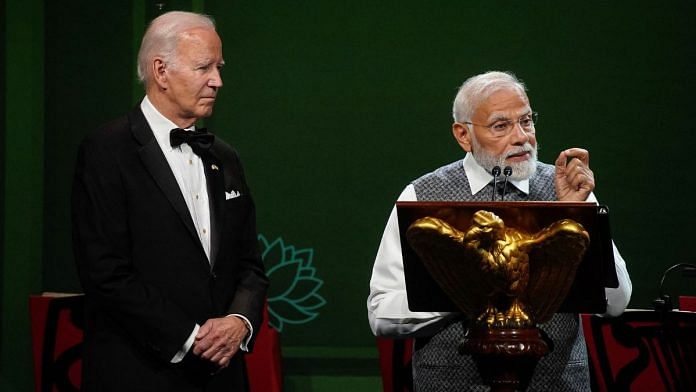Two major defence deals were signed during Prime Minister Narendra Modi’s US visit, building on previous agreements since the nuclear framework agreement signed between PM Manmohan Singh and President George Bush in 2005. These deals are rooted in India’s geographic location and its growing economic and diplomatic clout in the context of the ongoing global geopolitical struggle. They also align with the US’s efforts to protect its global hegemony, which is couched in a security framework, and involve India in defending common interests against a rising and aggressive China.
The contested geo-strategic space is the Indo-Pacific waters, which serve as crucial transit corridors for international trade, connecting Asian economic heartlands to resource and market hubs. China perceives any move by the US and its allies to control these key trade routes as a major threat to its economic development. The defence deals are transactional in nature and will likely be shaped by the trajectory of the China-US rivalry in the long run. To India, these deals provide alternatives to reduce its military dependence on Russia over time.
The recent momentum in India-US defence deals signifies a shift from primarily dealing with Russia’s public sector to deepening ties with the corporate and technological might of US military-industrial complex. However, this shift will be a different ball game for India. It requires new approaches from the Indian public and private sectors, guided by changes in government policies and regulatory frameworks. Without the necessary role played by the government and enabling the public and private sectors, these deals will not be able to realise the potential they hold for strengthening India’s military power.
India’s top political leaders cannot rest at just signing the deals but must oversee and guide the delivery of outcomes, which will be executed by the ministries concerned, especially the Ministry of Defence (MoD).
Also read: India-US ties reaching a turning point. But General Electric won’t ever get us complete tech
Go beyond technology transfer
The two major deals — co-production of the General Electric F414 fighter jet engine and the acquisition of MQ-9B drones — will test India’s Defence Industrial Base ecosystem in leveraging the political shift towards absorbing military capabilities from the US.
Beyond the reality of living in a world where there are enduring interests, not permanent friends or enemies, what lies at the heart of India’s quest for self-reliance is the ability to develop indigenous technology that no country would ever share. The jet engine deal provides insight into the nature of the problem.
While the exact details of the Memorandum of Understanding (MOU) for co-production may remain unknown, GE’s official statement provides a glimpse of the background and scope. GE has already committed to supplying ninety-nine F414 engines with a thrust of 98 Kn to power the Light Combat Aircraft (LCA) Mk2. The earlier version, the F404 engine with a thrust of 84 Kn, currently powers the LCA Mk1. GE has also been selected for prototype development and testing of the Advanced Medium Combat Aircraft (AMCA) programme with the F414-INS6, another advanced version. GE expects to collaborate on the AMCA Mk2 engine programme, targeting a 110-120 Kn thrust class.
Co-production with the Hindustan Aeronautics Limited (HAL) for the F414, including the degree of Transfer of Technology (ToT), is expected to drive progress towards India’s self-reliance in designing, developing, and producing jet engines. However, achieving this goal is still a bridge too far and primarily depends on the agreement reached regarding the ToT for co-production of F414. Media reports suggest that 80% technology transfer (12 key technologies) has been agreed upon. It is an impressive list. But what is not known are details of the remaining 20% technology. The enemy of self-reliance lies there and will require indigenous research and development, which falls under the mandate of the DRDO.
Also read: India’s defence sector is not Aatmanirbhar. Govt is exaggerating progress
What DRDO must do
There is a compelling case for the DRDO to concentrate its efforts on technologies that will not be readily transferred from foreign sources. This shift requires a major reorientation and restructuring of the DRDO.
As part of the reorientation, the DRDO should shed technologies that can be developed by India’s civil and private sectors, such as special rations and clothing. Once specific technologies are identified, the DRDO must be restructured by creating competing verticals within the organisation, which will obviate the monopoly that verticals enjoy currently because it faces no competition.
Therefore, if there are two verticals for aero-engines instead of one as at present, each of them can team up with different corporate entities to produce the prototype. This will foster a broader research and development base, and stimulate competitive progress in development of key technologies.
This transformation will also require changes in human capital management. All key positions must be open to qualified individuals and advertised, and selection must no longer be confined to DRDO scientists. Such reforms may face opposition within the DRDO and will require political intervention. In fact, similar practices should be adopted by identified sections within the government as well.
The political shift represented by the jet deal must now be converted into a final product and push progress in strengthening India’s indigenous capabilities. This potential can only be achieved if the DRDO shifts its focus, undergoes restructuring, and assimilates the best available human capital in the country.
Understandably, DRDO reform primarily focuses on research and development. The next stage, production, will require major reform of defence public sector undertakings, particularly Hindustan Aeronautics Limited (HAL), which will be the focus of my article next week.
Lt Gen (Dr) Prakash Menon (retd) is Director, Strategic Studies Programme, Takshashila Institution; former military adviser, National Security Council Secretariat. He tweets @prakashmenon51. Views are personal.



